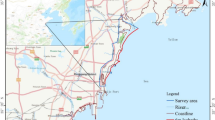Abstract
In this study, we interpreted coastal wetland types from an ASTER satellite image in 2002, and then compared the results with the land-use status of coastal wetlands in 1952 to determine the wetland loss and degradation around Jiaozhou Bay. Seven types of wetland landscape were classified, namely: shallow open water, inter-tidal flats, estuarine water, brackish marshes, salt ponds, fishery ponds and ports. Several landscape pattern indices were analysed: the results indicate that the coastal wetlands have been seriously degraded. More and more natural wetlands have been transformed into artificial wetlands, which covered about 33.7% of the total wetlands in 2002. In addition, we used a defined model to assess the impacts of human activities on coastal wetlands. The results obtained show that the coastal wetlands of Jiaozhou Bay have suffered severe human disturbance. Effective coastal management and control is therefore needed to solve the issues of the coastal wetland loss and degradation existing in this area.
Similar content being viewed by others

References
Farina, A. (2002). Landscape ecology in action. The Netherlands: Kluwer Academic Publisher.
Forman, R.T.T. (1995). Landscape mosatic: The ecology of landscape region. Cambridge University Press.
Forman R.T.T., & Godron, M. (1986). Landscape ecology. New York: John Wiley & Sons.
Graham, R.L. (1988). Indices of landscape pattern. Landscape Ecology, 1, 153–162.
Gu, D., Zhao, X., & Xia, D. (2003). Asystemic analysis of the environmental pressure factors to the degradation of coastal wetland in China. ACTA Oceanologica Sinica, 25, 78–85 (in Chinese).
Gustafson, E.J. (1998). Quantifying landscape spatial pattern: what is the state of the art? Ecosystems, 1, 143–156.
Hoozemans, F.M.J., Marchand, M., & Pennekamp, H. A. (1993). A global vulnerability analysis: Vulnerability assessment for population, coastal wetlands and rice production on a global scale (2nd Ed.), The Netherlands: Delft Hydraulics.
Hulshoff, R.M. (1995). Landscape indices describing a Dutch landscape. Landscape Ecology, 10, 101–111.
Iverson, L.R. (1988). Land-use change in Illinois, USA: The influence of landscape attributes on current and historic land use. Landscape Ecology, 2, 45–61.
Jaeger, J.A.G. (2000). Landscape division, splitting index, and effective mesh size: new measures of landscape fragmentation. Landscape Ecology, 15, 115–130.
McGarigal, K., & Marks, B.J. (1995). FRAGSTATS: Spatial Pattern Analysis Program For Quantifying Landscape Structure, Report No. PNW-GTR-351, USDA-Forest Service, Portland: Pacific Northwest Research Station.
O'Neill, R.V., Krummel, J.R., Gardner, R.H., Sugihara, G., Jackson, B., DeAngelis, D.L., Miline, B.T., Turner, M.G., Zygmunt, B., Christensen, S.W., Dale, V.H., Turner, M.G., & Gardner, R.H. (1991). Quantitative methods in landscape ecology. New York, USA: Springer-Verlag.
Turner, M.G., Gardner, R.H., & O'Neill, R. (2001). Landscape ecology in theory and practice: Pattern and process. New York: Springer-Verlag.
Urban, D.L., O'Neill, V., & Shugart Jr., H.H. (1987). Landscape ecology: a hierarchical perspective can help scientists understand spatial patterns. BioScience, 37, 119–127.
Wu, J. (2000). Landscape ecology: pattern, process, scale and hi- erarchy. Beijing, China: High Education Press (in Chinese).
Yang, M., Xia, D., Gu, D., Xue, Z., & Feng, A. (2005). Geographic environmental evolution in the Qingdao coastal area under the influence of global change. Advances in Marine Science, 23, 289–296 (in Chinese).
Yue, T., Haber, W., Herzog, F., Cheng T., Zhang, H.Q., & Wu, Q.H. (1998). Models for DLU strategy and their applications. Ekologia, 17 (Suppl. 1), 118–128.
Zhang, X., Zhang, Y., Sun, H., & Xia, D. (2005). Changes of hydrological environment and their influence on coastal wetlands in the southern Laizhou Bay, China. Environmental Monitoring and Assessment, (in press).
Zheng, Q., Wu, L., Zhang X., Sun, Y., Pan, J., & Xu, H. (1991). A remote sensing study of the Jiaozhou Bay-I. Measurement of total water area and coastal line length. Oceanologia and Limnologia Sincia, 22, 193–199 (in Chinese).
Author information
Authors and Affiliations
Corresponding author
Rights and permissions
About this article
Cite this article
Gu, D., Zhang, Y., Fu, J. et al. The landscape pattern characteristics of coastal wetlands in Jiaozhou Bay Under The Impact Of Human Activities. Environ Monit Assess 124, 361–370 (2007). https://doi.org/10.1007/s10661-006-9232-7
Received:
Accepted:
Published:
Issue Date:
DOI: https://doi.org/10.1007/s10661-006-9232-7



